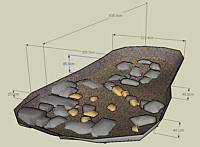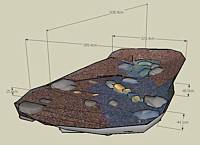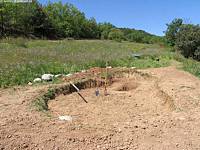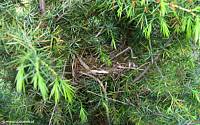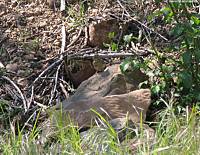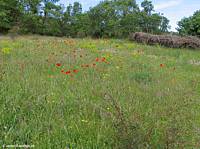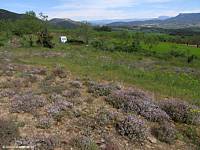|
|
Nature
Switched On
|
|
|
introduction |
2007 May 5, 6 & 7, from Saturday to Monday This weekend was going to be dedicated to the digging of a pond. Looking through the literature and internet it rapidly becomes clear that there is everything except unanimity about concepts and methods. To name just some polemic topics: while one resource advocates the use of rainwater, the other loathes it; one recommends letting the water settle down and not doing anything for two or three weeks, the other insists on putting oxygenating plants as soon as possible. I decided to go my own way, combine ideas from different authors and give nature itself as much protagonism as possible. These were my starting points:
|
|
| These SketchUp images illustrate the process with the first showing sizes and the position of some mayor boulders and the next showing the situation after the filling with pebbles, sandy soil and water.The area at the front is a gently sloping shallow marshy part while the deepest part (80cm) is at the rear, surrounded by boulders to retain the somewhat steeper slopes behind them. | ||
|
|
||
|
Cross section of the pond |
||
|
Armed with these premises I draw an outline of the future pond on
paper and then on the field and started to dig. I had a long sunny The next phase would be introducing a layer of fine sand (fortunately a big pile of this material was left behind by the previous owner) and installing the pond liner (1.2 mm of synthetic rubber (Butyl, EPDM) at around 8€/m2 at the local store) and another layer of fine sand and then filling the pond with a lot of river boulders and some sandy soil in order to create soft slopes and marshy areas. |
||
|
The future pond in the eastern
part of the terrain. Looking west. Monday 12:34 |
||
|
Rectification: with some embarrassment I must confess a serious mistake considering the beautiful birdsong we enjoy day and night that I commented on last week. I was already somewhat hesitating about its origin: the birds who produced the song were difficult to spot and when I saw something it looked quite brown with a reddish tail, not really the dark impression of a male blackbird. Also the fact that it sings in the middle of the night should have been an eye-opener: it is in fact a nightingale (Luscinia megarhynchos). In order to offer rehabilitation after the somewhat denigrating comments last week I offer here 1 minute of its beautiful song I recorded with my digital camera. |
||
|
Another
visiting bird was the Rock Sparrow (Petronia
petronia). It felt so at home that it decided to install its
nest in a Juniper shrub at 15 metres from our caravan. It honoured
its own name by always hipping on some nearby stones before entering
its nest, beautifully camouflaged inside the shrub. |
||
|
Nest of the Rock Sparrow in a Juniper shrub Sunday 19:58 |
The Rock Sparrow always
approaches its nest cautiously via some big stones Saturday 12:54 |
|
|
Needless to say that the terrain was offering a marvellous look at this time of the year, in which I can add 6 or 7 new species per week to the floristic catalogue. I hope to introduce soon a faunistic catalogue to do some justice to all the insects, birds and mammals.
|
||
|
Rosa sp,
Euphorbia cyparissias, Papaver rhoeas,
Helianthemum violaceum,
Bromus diandrus
Monday 11:06 |
Overview looking northwest. Monday 11:11 |
|
|
introduction
|
|
|
